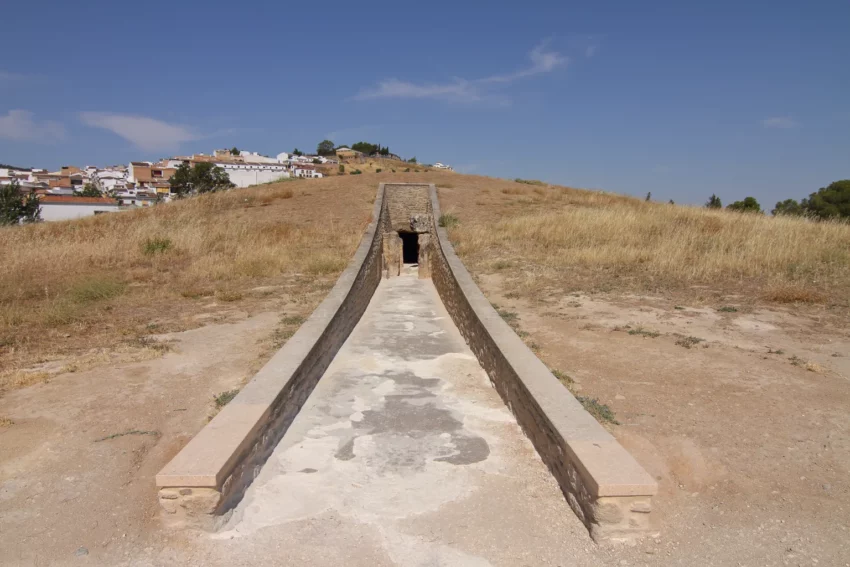The Dolmen de Viera is a megalithic burial monument located in Antequera, Spain. It’s part of the Antequera Dolmens Site, a UNESCO World Heritage site. This dolmen, a type of single-chamber megalithic tomb, dates back to the Neolithic and Bronze Age. It consists of a long corridor and a burial chamber, built with large stone slabs. The Dolmen de Viera is a testament to the engineering skills of prehistoric societies and provides insight into their burial practices and cosmological beliefs.
Get your dose of History via Email
Historical Background of Dolmen de Viera
The Dolmen de Viera, discovered in 1903 by brothers Antonio and José Viera, is a marvel of prehistoric architecture. It was built during the Neolithic period, around 2500 to 2000 BC. The builders of this dolmen were part of a society that settled in the fertile lands of Antequera. Over time, the site has captivated historians and archaeologists alike. Its discovery shed light on the sophisticated burial rituals of ancient communities in Southern Spain.
Constructed with large stone slabs, the Dolmen de Viera served as a burial place for the elite. It’s part of a larger complex that includes the Menga and El Romeral dolmens. These structures reflect the collective effort of a well-organized society. The builders had a deep understanding of stonework and astronomy. The orientation of the Dolmen de Viera suggests a connection with the cycles of the sun.
While primarily a burial site, the Dolmen de Viera may have had other functions. Some suggest it played a role in rituals or as a place of worship. Throughout history, the site remained untouched until its modern discovery. This allowed for excellent preservation. The site has not been the scene of historically significant events in recent times. Yet, it stands as a silent witness to the ingenuity of our ancestors.
The Dolmen de Viera’s builders remain a mystery. They left no written records. However, the monument’s construction techniques mirror those found in other megalithic sites across Europe. This suggests a shared cultural background. The site has not seen later inhabitants. Its purpose and use seem to have been strictly linked to the prehistoric era in which it was built.
Today, the Dolmen de Viera is an important historical and cultural landmark. It attracts scholars and tourists alike. Its discovery has contributed significantly to our understanding of prehistoric societies in Europe. The site remains a focal point for research into megalithic structures and their place in ancient human history.
About Dolmen de Viera
The Dolmen de Viera is a corridor-type dolmen, characterized by its long passage leading to a burial chamber. The structure is made up of vertical slabs of stone, topped with horizontal capstones. These stones, known as orthostats and megaliths, were sourced locally. They demonstrate the builders’ ability to manipulate large stones with limited technology.
The passage of the Dolmen de Viera is about 21 meters long. It narrows as it approaches the chamber. The chamber itself is small, with a false dome created by progressively smaller stones. This technique is known as corbelling. The entire structure was once covered by a mound of earth, known as a tumulus, which has since eroded away.
Architectural highlights of the Dolmen de Viera include its precise alignment with the sunrise during the equinoxes. This suggests that the builders had astronomical knowledge. The stones are also arranged in a way that creates a play of light and shadow inside the passage. This effect may have had symbolic significance related to the afterlife.
The construction methods of the Dolmen de Viera are a testament to the engineering skills of its builders. They used simple tools made of stone, wood, and bone. The transportation and placement of the megaliths would have required a coordinated effort. This indicates a high level of social organization.
The Dolmen de Viera’s design and construction have been preserved remarkably well over the millennia. This allows for a detailed study of its features. The site provides a tangible connection to the past. It offers a glimpse into the architectural practices of prehistoric societies in the region.
Theories and Interpretations
Several theories exist about the Dolmen de Viera’s purpose and significance. Most agree it served as a burial site. Yet, its exact role within the society that built it is subject to interpretation. Some scholars suggest it was a place of worship or a site for ritualistic ceremonies.
The precise alignment with the equinox sunrise has led to theories about the dolmen’s astronomical significance. It may have functioned as a calendar or a way to mark seasonal changes. This would have been important for agricultural societies dependent on the cycles of nature.
Mysteries surround the Dolmen de Viera, particularly regarding the methods used in its construction. The transportation of the massive stones without the aid of modern machinery is a subject of wonder. Theories suggest the use of logs, ropes, and human or animal power.
Interpretations of the site have also been matched to historical records from similar megalithic structures. This has provided a broader context for understanding the Dolmen de Viera. Comparisons with other dolmens across Europe suggest a widespread megalithic culture with shared architectural and ceremonial practices.
Dating of the Dolmen de Viera has been carried out using various methods. Radiocarbon dating of organic materials found within the site has helped establish its age. This scientific approach has confirmed the dolmen’s construction during the Neolithic to Bronze Age transition.
At a glance
Country: Spain
Civilization: Neolithic and Bronze Age societies
Age: Approximately 4,500 to 5,000 years old (2500 to 2000 BC)

